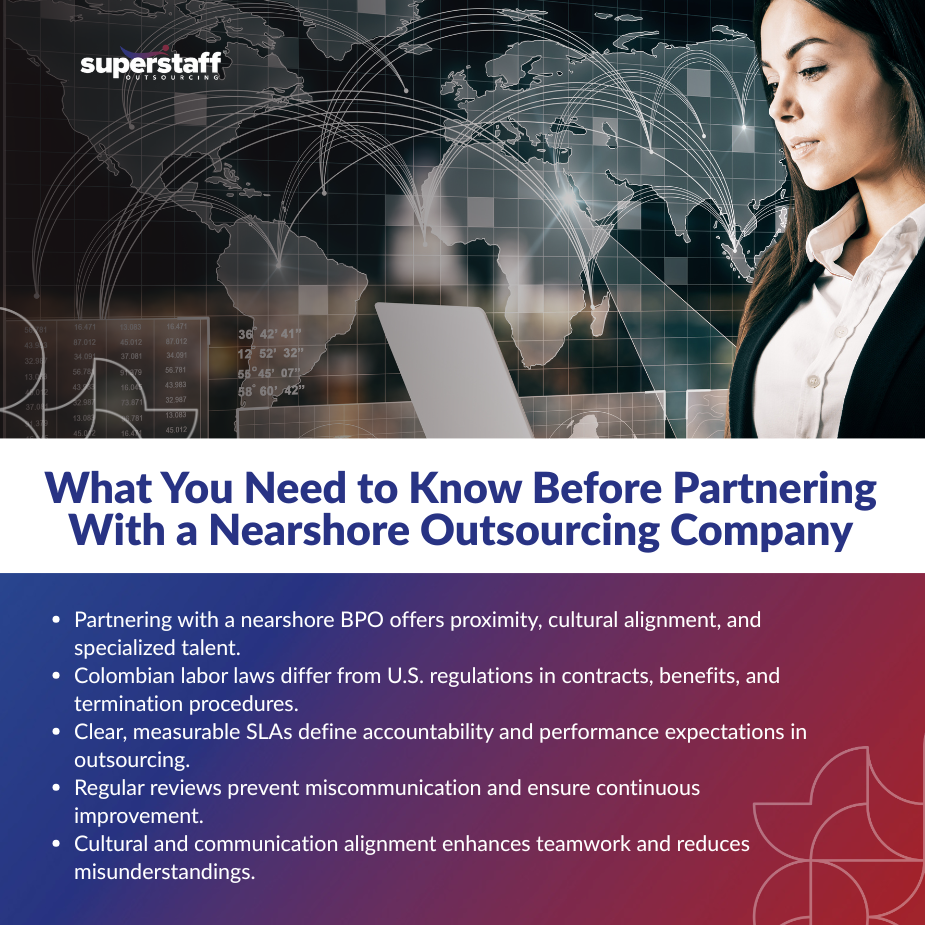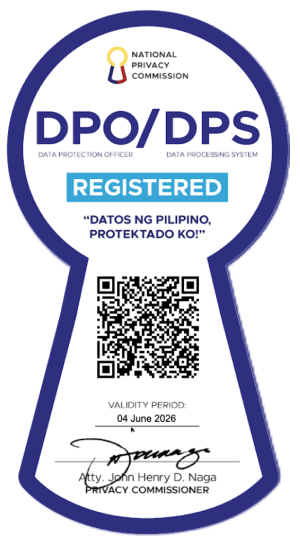
Nearshore outsourcing is no longer just a trend; it’s a strategic move reshaping how modern businesses operate. As companies seek agility, cost efficiency, and real-time collaboration, many are turning to a nearshore outsourcing company to extend their capabilities without the challenges of distance or drastic time zone gaps. This growing preference for nearshoring reflects a shift toward partnerships that blend proximity with specialized talent and shared cultural values.
But while nearshoring offers opportunities to scale quickly and maintain quality control, success doesn’t happen by accident. Businesses must enter these partnerships with clarity, compliance, and cultural understanding. Each decision, from how contracts are structured to how teams communicate, plays a defining role in long-term success.
In this blog, we’ll explore what every business leader should know before launching a nearshore partnership. From navigating labor laws and crafting effective Service-Level Agreements (SLAs) to bridging cultural differences, we’ll cover the essential elements that turn a nearshore arrangement into a reliable, high-performing collaboration.
Understanding Labor Laws in Nearshore Markets
Before entering into a nearshore partnership, companies must first understand the local labor laws that shape hiring, wages, and working conditions. Compliance isn’t just a matter of following the law—it’s about protecting both your business and your workforce while fostering trust and sustainability.
Every nearshore outsourcing company operates under a distinct set of regulations that may differ significantly from U.S. labor standards. For instance, some nearshore markets have mandatory benefits like 13th-month pay, extended maternity or paternity leave, or legally required rest days.
Others set clear probationary periods before employees are regularized or establish national minimum wages that are updated annually. Understanding these nuances is vital because what works legally in one country may not translate to another.
When it comes to compliance labor, U.S. companies must also be aware of local employment contracts and statutory obligations. Unlike the “at-will” employment system common in the United States, many nearshore countries require just cause for termination and impose severance obligations if an employee is dismissed without cause. These laws aim to protect workers’ rights while ensuring businesses maintain fair employment practices.
Key areas to pay close attention to include:
- Minimum wage laws: These vary by country and sometimes by region within the same country.
- Holiday pay and leave entitlements: Public holidays and vacation accrual rules differ, and failure to honor them can lead to penalties.
- Termination processes: Ensure all dismissal procedures are documented and compliant with local statutes to avoid disputes or legal claims.
By proactively managing compliance labor, you minimize risks such as lawsuits, back pay claims, or damage to your reputation. More importantly, you demonstrate respect for the workforce and commitment to ethical business practices. Once legal compliance is clear, attention shifts to the operational backbone of outsourcing: the Service-Level Agreement.

Service-Level Agreements as the Foundation of Partnership
Service-level agreements (SLAs) are not just technical documents; they’re the framework that defines performance expectations and accountability in nearshore outsourcing. A well-drafted SLA ensures both sides, client and provider, understand what success looks like and how it will be measured.
When working with a nearshore outsourcing company, the SLA is the bridge that connects strategic intent with daily execution. It aligns metrics, deliverables, and quality benchmarks to the goals of the partnership. Common SLA performance indicators include:
- Response time: How quickly a support agent or team member responds to a ticket or request.
- Resolution time: The duration it takes to resolve an issue fully.
- Uptime guarantees: For technical support or IT services, uptime commitments maintain business continuity.
But beyond metrics, clarity is key. One of the most common pitfalls businesses face when outsourcing is failing to define clear, measurable targets. Vague agreements can lead to conflicting interpretations, strained relationships, and unmet expectations. When clients and providers view success differently, accountability becomes blurred.
To avoid such issues, businesses must focus on what to include in a service level agreement before starting a nearshore partnership. This includes:
- Specific deliverables: Outline exactly what services are being provided and their expected quality.
- Measurable KPIs: Define what metrics matter most and how they will be tracked.
- Reporting and review processes: Establish how often performance will be reviewed and what tools will be used for transparency.
- Remediation procedures: Clearly state what happens if standards aren’t met—whether through penalties, additional training, or revised processes.
Transparency builds trust. Regular performance reviews and benchmarking against industry standards keep both parties aligned and continuously improving. When your SLA performance is reviewed consistently, small issues are caught early, and adjustments can be made before they snowball into larger operational setbacks.
While laws and contracts set the structure, it’s cultural and communication alignment that ensures smooth day-to-day operations—a factor often underestimated but critical for success.
Bridging Cultural and Communication Gaps
Even with solid contracts and clear SLAs in place, cultural understanding remains the glue that holds nearshore partnerships together. A company’s ability to bridge cultural differences often determines whether collaboration feels natural or forced.
One of the greatest advantages of partnering with a nearshore outsourcing company is proximity; not just in time zones, but in culture and language. Shared business hours mean real-time collaboration without late-night calls or delayed responses. English proficiency in key nearshore hubs such as Colombia allows seamless communication, while cultural similarities foster smoother team integration.
However, businesses shouldn’t assume proximity guarantees understanding. Cultural fluency training, empathy in leadership, and sensitivity to communication styles are all critical in nurturing trust and productivity. For example, some cultures value hierarchy and formal communication, while others prefer open, collaborative dialogue. Recognizing and respecting these differences prevents misinterpretations and fosters stronger professional relationships.
To ensure cultural alignment:
- Invest in cross-cultural training: Teach teams to understand workplace etiquette, communication styles, and business norms.
- Encourage open feedback: Create channels for transparent discussions that strengthen collaboration.
- Celebrate diversity: Use cultural exchange as a way to build team morale and shared identity.
When both teams align culturally, synergy happens naturally. Managers find it easier to delegate, employees feel more valued, and results improve across all fronts. Once cultural harmony is established, the next step is anticipating and managing potential risks.
Risk Management and Contingency Planning
A strong partnership anticipates challenges and plans for continuity. Whether it’s a natural disaster, political instability, or a sudden labor strike, nearshore partnerships need to prepare for disruptions that can impact operations.
Every reputable nearshore outsourcing company builds contingency plans to ensure service consistency even in uncertain times. Business continuity planning (BCP) goes beyond having backup systems—it’s about designing resilient workflows that protect clients from downtime or data loss.
Key considerations in risk management include:
- Disaster recovery protocols: Ensure your nearshore provider has redundant systems, offsite data storage, and a clear escalation matrix.
- Cybersecurity awareness: With data privacy laws evolving globally, your outsourcing partner must comply with international standards such as GDPR or HIPAA.
- Crisis communication plans: Determine how information flows between teams during emergencies.
When evaluating partners, ask how they approach compliance labor in relation to data privacy and worker safety. For instance, are security awareness training sessions mandatory? How do they handle hybrid work arrangements while maintaining compliance with both local and client-side regulations? These factors can determine how well a partner can protect your brand reputation.
In the age of digital transformation, risk management also means guarding against technological vulnerabilities. System downtime, breaches, or noncompliance with security protocols can have serious legal and financial implications. Hence, robust documentation of procedures, periodic audits, and collaboration between client and vendor IT teams are crucial.
Beyond managing risks, the true potential of nearshoring lies in scaling responsibly and sustaining the partnership for long-term success.
Preparing for Growth and Long-Term Partnership
Nearshore outsourcing should be seen not just as a cost-saver but as a strategic long-term partnership. When you partner with a nearshore outsourcing company, you’re investing in a relationship that can evolve alongside your business.
Growth requires flexibility. The best partnerships are built on contracts that allow scalability—expanding teams, adding new service lines, or adjusting to seasonal demands without compromising performance. A rigid agreement may save short-term costs but often limits agility in responding to business changes.
To sustain long-term success:
- Build flexible contracts: Include clauses that allow workforce expansion or service adjustments.
- Focus on continuous improvement: Periodic reviews of SLA performance encourage innovation and efficiency.
- Align goals with strategy: Ensure the partner’s growth trajectory complements your organization’s vision.
Investing in talent development within your nearshore team also pays dividends. Upskilling initiatives, technology integration, and leadership training help maintain engagement and strengthen output quality. Encourage collaborative tools and shared analytics dashboards to keep everyone aligned in real time.
Technology is another major enabler of sustainable growth. Cloud-based solutions, AI-powered performance tracking, and automation tools help streamline workflows between client and nearshore teams. These innovations allow your company to achieve higher productivity while maintaining transparency.
Ultimately, a nearshore partnership thrives when both sides see each other as extensions of the same organization. Regular alignment meetings, shared success metrics, and open communication channels help maintain momentum as the business evolves.
Kick-Start Your BPO Partnership With a Trusted and Reliable Nearshore Outsourcing Company
Nearshore outsourcing thrives on a balance of structure, trust, and adaptability. A company that invests in understanding local labor laws, defining clear expectations through SLAs, and fostering cultural alignment builds a foundation for long-term success. Legal compliance protects the workforce, SLA performance ensures accountability, and proactive risk management safeguards business continuity.
Partnering with a nearshore outsourcing company is more than a business transaction—it’s a shared journey of growth, collaboration, and innovation. When done right, nearshoring doesn’t just optimize operations; it creates resilient, future-ready teams capable of driving competitive advantage in an ever-changing global economy.
Ready to start your nearshore journey? Let SuperStaff guide you through every step—from navigating compliance labor requirements to defining what to include in a service level agreement before starting a nearshore partnership. Our experienced teams in Colombia and the Philippines are equipped to help your business scale with confidence, efficiency, and cultural synergy.
Partner with SuperStaff today—where proximity meets performance.






